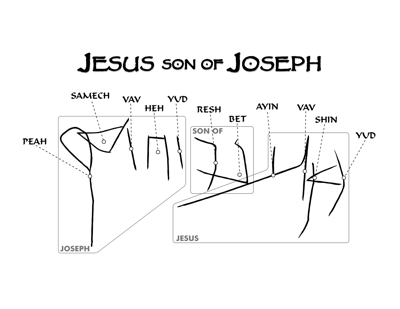How Common Are The Names in the Talpiot “Jesus” Tomb: A New Study
The first and most frequent response one gets to any suggestion that the Talpiot “Jesus” tomb might be that of Jesus of Nazareth and his family is “But weren’t these names common in that time?” One hears this from academic colleagues, both high and low, from media people, and from the public, either at lectures or in comments all over the Internet. It is kind of amazing to me that this assertion, which has been shown to be demonstrably untrue, has become a virtual mantra, almost like the proverbial “knee-jerk” reaction.

The best recent academic studies of this subject, easily accessible on-line, are those of Mark Elliot and Kevin Kilty, and the overview provided by statistician Jerry Lutgen.[1] For anyone who wants to make informed comments these seem to me to be the place to begin:
M. Elliott and K. Kilty, “Inside the Numbers of the Talpiot Tomb.”
M. Elliott and K. Kilty, “Probability, Statistics, and the Talpiot Tomb.”
Jerry Lutgen, “The Talpiot Tomb: What Are the Odds?”
We now have a new study by Prof. Claude Cohen-Matlofsky, of the University of Toronto and the Sorbonne, a summary of which was just posted yesterday. Cohen-Matlofsky’s full study will come out in the forthcoming volume of papers from the 2008 Jerusalem Talpiot Tomb Conference edited by James Charlesworth.[2] Her piece view resets our question in a remarkable way by suggesting a new a more precise method of calculating “onomastics” or name frequencies in the late 2nd Temple period. I urge a careful reading:
“Onomastics and Statistics in Second Temple Judaism,” July, 2012
This work comes out of Prof. Cohen-Matlofsky’s larger work, published in her influential book, Les Laïcs en Palestine d’Auguste à Hadrien: étude prosopographique (2001). What Cohen-Matlofsky has undertaken is a much tighter chronological calculation (63 BCE to 70 CE.) of the occurrences of various Jewish names, both male and female, in the period, as well as a broader and more comprehensive sampling than just names on ossuaries. She points out, for example, that Tal Ilan’s most useful lexicon includes names from 330 BCE to 200 CE, which is a very broad chronological swath, and that is what many of us have relied upon.[3] Although Tal Ilan includes other sources beyond ossuary inscriptions Cohen-Matlofsky has been able to update, expand, and in some places correct, her tallies. Tal Ilan’s data on the Talpiot tomb names, as tabulated by John Koopmans, my researcher, is available here. Cohen-Matlofsky explains:
In my research, I drew names from the writings of Flavius Josephus and other ancient authors, biblical, and rabbinical sources, including the New Testament , the documents of Qumran, Murabba’at and other caves of the Judean desert and finally the archeological material, especially funerary inscriptions mostly found in rock-cut tombs excavated in and around Jerusalem.
Rahmani’s classic Catalogue of Jewish Ossuaries, only goes down through 1989, even though he published it in 1994, and it is restricted to those ossuaries in the Israel State Collection. The 227 inscribed ossuaries Rahmani includes must now be expanded to more than 600 as now listed in Cotton, et al., Corpus Inscriptionnum Iudaeae/Palaestinae. See my own tabulation of the Talpiot tomb names based on Cotton’s CIIP here.
One interesting result is that the name Yeshua, in its variables in both Greek and Hebrew/Aramaic, rather than being the most common ends up being the least common of the names in the Talpiot tomb. The name Matiah turns out to be quite rare while the name Miriam comes in behind Salome in its various forms, which is the most common female name. These results interesting to compare with those of Rachel Hachlili, who attempts to gather from a similar set of data bases.[4]
I commend Prof. Cohen-Matlofsky for this latest effort and I look forward to reading the full account of her research in the forthcoming Charlesworth volume mentioned above. I also thank the editors at Bible & Interpretation for continuing to post the latest and best studies on the Talpiot tombs, reflecting all points of view and allowing respectful on-line discussion. I urge my blog readers to try a search at that site for “Talpiot” or the “James ossuary.” You will be amazed at the wealth of materials archived there.
[1] There is of course the peer reviewed foundational work of Andrey Fuerverger, “Statistical Analysis of an Archeological Find,” in Annals of Applied Statistics, 2, 2008, pp. 3-54. Although Fuerverger’s critics have raised some legitimate questions about his method and assumption his professional responses to them, published at the end of his article, have been too often ignored
[2] The Tomb of Jesus and His Family? Exploring Ancient Jewish Tombs Near Jerusalem’s Walls, edited by James H. Charlesworth and Arthur Boulet
[3] Lexicon of Jewish Names in Late Antiquity, Mohr Siebeck, 2002
[4] Jewish Funerary Customs, Practices And Rites In The Second Temple Period, Brill, 2005, p. 196-200

